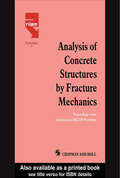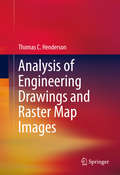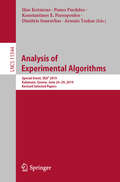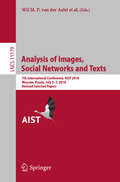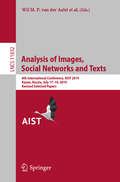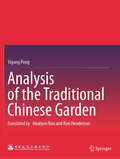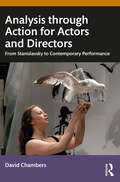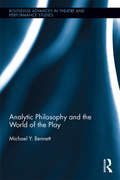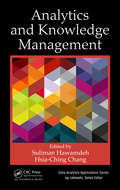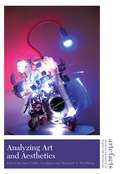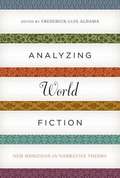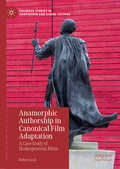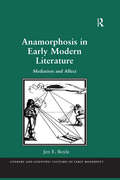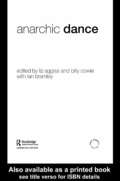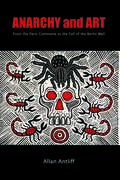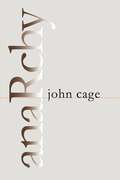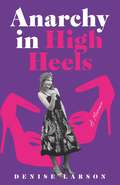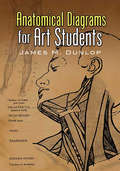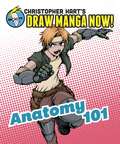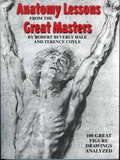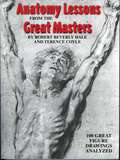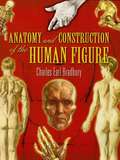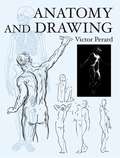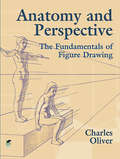- Table View
- List View
Analysis of Concrete Structures by Fracture Mechanics: Proceedings of a RILEM Workshop dedicated to Professor Arne Hillerborg, Abisko, Sweden 1989
by S. P. Shah L. ElfgrenThis book presents the latest research findings of the fast developing applications of fracture mechanics to concrete structures. Key papers from leading experts in the field describe existing and new modelling techniques in the analysis of materials and structures. The book explains the practical application of fracture mechanics to structural mod
Analysis of Engineering Drawings and Raster Map Images
by Thomas HendersonThis book covers up-to-date methods and algorithms for the automated analysis of engineering drawings and digital cartographic maps. The Non-Deterministic Agent System (NDAS) offers a parallel computational approach to such image analysis. The book describes techniques suitable for persistent and explicit knowledge representation for engineering drawings and digital maps. It also highlights more specific techniques, e.g., applying robot navigation and mapping methods to this problem. Also included are more detailed accounts of the use of unsupervised segmentation algorithms to map images. Finally, all these threads are woven together in two related systems: NDAS and AMAM (Automatic Map Analysis Module).
Analysis of Experimental Algorithms: Special Event, SEA² 2019, Kalamata, Greece, June 24-29, 2019, Revised Selected Papers (Lecture Notes in Computer Science #11544)
by Panos Pardalos Ilias Kotsireas Konstantinos E. Parsopoulos Dimitris Souravlias Arsenis TsokasThis book constitutes the refereed post-conference proceedings of the Special Event on the Analysis of Experimental Algorithms, SEA² 2019, held in Kalamata, Greece, in June 2019.The 35 revised full papers presented were carefully reviewed and selected from 45 submissions. The papers cover a wide range of topics in both computer science and operations research/mathematical programming. They focus on the role of experimentation and engineering techniques in the design and evaluation of algorithms, data structures, and computational optimization methods.
Analysis of Images, Social Networks and Texts: 7th International Conference, AIST 2018, Moscow, Russia, July 5–7, 2018, Revised Selected Papers (Lecture Notes in Computer Science #11179)
by Vladimir Batagelj Panos M. Pardalos Andrey V. Savchenko Dmitry I. Ignatov Olessia Koltsova Wil M. P. van der Aalst Marcello Pelillo Alexander Panchenko Michael Khachay Natalia Loukachevitch Sergei O. Kuznetsov Irina A. Lomazova Amedeo Napoli Goran GlavašThis book constitutes the proceedings of the 7th International Conference on Analysis of Images, Social Networks and Texts, AIST 2018, held in Moscow, Russia, in July 2018. The 29 full papers were carefully reviewed and selected from 107 submissions (of which 26 papers were rejected without being reviewed). The papers are organized in topical sections on natural language processing; analysis of images and video; general topics of data analysis; analysis of dynamic behavior through event data; optimization problems on graphs and network structures; and innovative systems.
Analysis of Images, Social Networks and Texts: 8th International Conference, AIST 2019, Kazan, Russia, July 17–19, 2019, Revised Selected Papers (Lecture Notes in Computer Science #11832)
by Vladimir Batagelj Panos M. Pardalos Andrey V. Savchenko Dmitry I. Ignatov Wil M. P. van der Aalst Marcello Pelillo Michael Khachay Natalia Loukachevitch Sergei O. Kuznetsov Irina A. Lomazova Amedeo Napoli Valentina Kuskova Andrey Kutuzov Elena TutubalinaThis book constitutes the post-conference proceedings of the 8th International Conference on Analysis of Images, Social Networks and Texts, AIST 2019, held in Kazan, Russia, in July 2019. The 27 full and 8 short papers were carefully reviewed and selected from 134 submissions (of which 21 papers were automatically rejected without being reviewed). The papers are organized in topical sections on general topics of data analysis; natural language processing; social network analysis; analysis of images and video; optimization problems on graphs and network structures; and analysis of dynamic behavior through event data.
Analysis of the Traditional Chinese Garden
by Yigang PengAnalysis of the Traditional Chinese Garden is a seminal resource for the spatial principles and techniques that shape traditional Chinese gardens. It is a richly illustrated resource for historians, theorists, garden designers, landscape architects, architects and anyone interested in the design of these world renowned gardens with 106 pages of hand-drawn sketches by the author that vividly portray the intricacies and subtleties of traditional Chinese gardens. The book is widely known in China as a primary text for analysis of the gardens and was recognized with the inaugural National Excellent Architectural Book Award in 1990 and, since its debut in China in 1986, has garnered immense popularity and acclaim with 50 reprints and a total print run of 150,000 copies.
Analysis through Action for Actors and Directors: From Stanislavsky to Contemporary Performance
by David ChambersAnalysis through Action for Actors and Directors is a comprehensive view of an innovative and exciting process for making new theatre.As well as an understanding of how Analysis through Action has developed over time, this book also demonstrates how it can be put into practice in today’s theatre. The first part of this book traces the exciting genealogy from Stanislavsky’s unfinished experiments, through the insights of geniuses Maria Knebel and Georgii Tovstonogov, down to today’s avant-garde auteurs. The second part is a practical manual based on extensive field testing by the author and colleagues. Here, two key components of the process are elucidated: Text Actions – ten interwoven text analysis steps – to be twinned with the thrilling rehearsal process using focused and joyful improvisations called Études.Written for new or experienced theatre students and practitioners, this book will enrich the technique of any theatre artist and anyone else interested in the theatre and its future.
Analytic Philosophy and the World of the Play (Routledge Advances in Theatre & Performance Studies)
by Michael Y. BennettTheatrical characters’ dual existence on stage and in text presents a unique, challenging case for the analytical philosopher. Analytic Philosophy and the World of the Play re-examines the ontological status of theatre and its fictional objects through the "possible worlds" thesis, arguing that theatre is not a mirror of our world, but a re-creation of it. Taking a fresh look at theatre’s key elements, including the hotly contested relationships between character and actor; onstage and offstage "worlds"; and the play-text and performance, Michael Y. Bennett presents a radical new way of understanding the world of the play.
Analytics and Knowledge Management (Data Analytics Applications)
by Suliman Hawamdeh and Hsia-Ching ChangThe process of transforming data into actionable knowledge is a complex process that requires the use of powerful machines and advanced analytics technique. Analytics and Knowledge Management examines the role of analytics in knowledge management and the integration of big data theories, methods, and techniques into an organizational knowledge management framework. Its chapters written by researchers and professionals provide insight into theories, models, techniques, and applications with case studies examining the use of analytics in organizations. The process of transforming data into actionable knowledge is a complex process that requires the use of powerful machines and advanced analytics techniques. Analytics, on the other hand, is the examination, interpretation, and discovery of meaningful patterns, trends, and knowledge from data and textual information. It provides the basis for knowledge discovery and completes the cycle in which knowledge management and knowledge utilization happen. Organizations should develop knowledge focuses on data quality, application domain, selecting analytics techniques, and on how to take actions based on patterns and insights derived from analytics. Case studies in the book explore how to perform analytics on social networking and user-based data to develop knowledge. One case explores analyze data from Twitter feeds. Another examines the analysis of data obtained through user feedback. One chapter introduces the definitions and processes of social media analytics from different perspectives as well as focuses on techniques and tools used for social media analytics. Data visualization has a critical role in the advancement of modern data analytics, particularly in the field of business intelligence and analytics. It can guide managers in understanding market trends and customer purchasing patterns over time. The book illustrates various data visualization tools that can support answering different types of business questions to improve profits and customer relationships. This insightful reference concludes with a chapter on the critical issue of cybersecurity. It examines the process of collecting and organizing data as well as reviewing various tools for text analysis and data analytics and discusses dealing with collections of large datasets and a great deal of diverse data types from legacy system to social networks platforms.
Analyzing Art and Aesthetics (Artefacts: Studies in the History of Science and Technology #9)
by Margaret A. Weitekamp Anne Collins GoodyearThis ninth volume of the Artefacts series explores how artists have responded to developments in science and technology, past and present. Rather than limiting the discussion to art alone, editors Anne Collins Goodyear and Margaret Weitekamp also asked contributors to consider aesthetics: the scholarly consideration of sensory responses to cultural objects. When considered as aesthetic objects, how do scientific instruments or technological innovations reflect and embody culturally grounded assessments about appearance, feel, and use? And when these objects become museum artifacts, what aesthetic factors affect their exhibition? Contributors found answers in the material objects themselves. This volume reconsiders how science, technology, art, and aesthetics impact one another.
Analyzing Narrative: Discourse and Sociolinguistic Perspectives
by Anna De Fina Alexandra GeorgakopoulouThe socially minded linguistic study of storytelling in everyday life has been rapidly expanding. This book provides a critical engagement with this dynamic field of narrative studies, addressing long-standing questions such as definitions of narrative and views of narrative structure but also more recent preoccupations such as narrative discourse and identities, narrative language, power and ideologies. It also offers an overview of a wide range of methodologies, analytical modes and perspectives on narrative from conversation analysis to critical discourse analysis, to linguistic anthropology and ethnography of communication. The discussion engages with studies of narrative in multiple situational and cultural settings, from informal-intimate to institutional. It also demonstrates how recent trends in narrative analysis, such as small stories research, positioning analysis and sociocultural orientations, have contributed to a new paradigm that approaches narratives not simply as texts, but rather as complex communicative practices intimately linked with the production of social life.
Analyzing World Fiction
by Frederick Luis AldamaWhy are many readers drawn to stories that texture ethnic experiences and identities other than their own? How do authors such as Salman Rushdie and Maxine Hong Kingston, or filmmakers in Bollywood or Mexico City produce complex fiction that satisfies audiences worldwide? In Analyzing World Fiction, fifteen renowned luminaries use tools of narratology and insights from cognitive science and neurobiology to provide answers to these questions and more. With essays ranging from James Phelan’s “Voice, Politics, and Judgments in Their Eyes Were Watching God” and Hilary Dannenberg’s “Narrating Multiculturalism in British Media: Voice and Cultural Identity in Television” to Ellen McCracken’s exploration of paratextual strategies in Chicana literature, this expansive collection turns the tide on approaches to postcolonial and multicultural phenomena that tend to compress author and narrator, text and real life. Striving to celebrate the art of fiction, the voices in this anthology explore the “ingredients” that make for powerful, universally intriguing, deeply human story-weaving. Systematically synthesizing the tools of narrative theory along with findings from the brain sciences to analyze multicultural and postcolonial film, literature, and television, the contributors pioneer new techniques for appreciating all facets of the wonder of storytelling.
Anamorphic Authorship in Canonical Film Adaptation: A Case Study of Shakespearean Films (Palgrave Studies in Adaptation and Visual Culture)
by Robert GealThis book develops a new approach for the study of films adapted from canonical ‘originals’ such as Shakespeare’s plays. Departing from the current consensus that adaptation is a heightened example of how all texts inform and are informed by other texts, this book instead argues that film adaptations of canonical works extend cinema’s inherent mystification and concealment of its own artifice. Film adaptation consistently manipulates and obfuscates its traces of ‘original’ authorial enunciation, and oscillates between overtly authored articulation and seemingly un-authored unfolding. To analyse this process, the book moves from a dialogic to a psychoanalytic poststructuralist account of film adaptations of Shakespeare’s plays. The differences between these rival approaches to adaptation are explored in depth in the first part of the book, while the second part constructs a taxonomy of the various ways in which authorial signs are simultaneously foregrounded and concealed in adaptation’s anamorphic drama of authorship.
Anamorphosis in Early Modern Literature: Mediation and Affect (Literary and Scientific Cultures of Early Modernity)
by Jen E. BoyleAnamorphosis in Early Modern Literature explores the prevalence of anamorphic perspective in the seventeenth and eighteenth centuries in England. Jen Boyle investigates how anamorphic media flourished in early modern England as an interactive technology and mode of affect in public interactive art, city and garden design, and as a theory and figure in literature, political theory and natural and experimental philosophy. Anamorphic mediation, Boyle brings to light, provided Milton, Margaret Cavendish, and Daniel Defoe, among others, with a powerful techno-imaginary for traversing through projective, virtual experience. Drawing on extensive archival research related to the genre of "practical perspective" in early modern Europe, Boyle offers a scholarly consideration of anamorphic perspective (its technical means, performances, and embodied practices) as an interactive aesthetics and cultural imaginary. Ultimately, Boyle demonstrates how perspective media inflected a diverse set of knowledges and performances related to embodiment, affect, and collective consciousness.
Anarchic Dance
by Liz Aggiss Billy Cowie Ian BramleyLiz Aggiss and Billy Cowie, known collectively as Divas Dance Theatre, are renowned for their highly visual, interdisciplinary brand of dance performance that incorporates elements of theatre, film, opera, poetry and vaudevillian humour. Anarchic Dance, consisting of a book and DVD-Rom, is a visual and textual record of their boundary-shattering performance work. The DVD-Rom features extracts from Aggiss and Cowie's work, including the highly-acclaimed dance film Motion Control (premiered on BBC2 in 2002), rare video footage of their punk-comic live performances as The Wild Wigglers and reconstructions of Aggiss's solo performance in Grotesque Dancer. These films are cross-referenced in the book, allowing readers to match performance and commentary as Aggiss and Cowie invite a broad range of writers to examine their live performance and dance screen practice through analysis, theory, discussion and personal response. Extensively illustrated with black and white and colour photographs Anarchic Dance, provides a comprehensive investigation into Cowie and Aggiss’s collaborative partnership and demonstrates a range of exciting approaches through which dance performance can be engaged critically.
Anarchy and Art
by Allan AntliffOne of the powers of art is its ability to convey the human aspects of political events. In this fascinating survey on art, artists, and anarchism, Allan Antliff interrogates critical moments when anarchist artists have confronted pivotal events over the past 140 years. The survey begins with Gustave Courbet's activism during the 1871 Paris Commune (which established the French republic) and ends with anarchist art during the fall of the Soviet empire. Other subjects include the French neoimpressionists, the Dada movement in New York, anarchist art during the Russian Revolution, political art of the 1960s, and gay art and politics post-World War II. Throughout, Antliff vividly explores art's potential as a vehicle for social change and how it can also shape the course of political events, both historic and present-day; it is a book for the politically engaged and art aficionados alike. Allan Antliff is the author of Anarchist Modernism.
Anarchy: New York City–January 1988
by John CageWinner of the Association of American University Presses (AAUP) Book, Jacket, and Journal Show – Best Scholarly Typography (2002)"That government is best which governs not at all; and when men are prepared for it, that will be the kind of government which they will have." This quote from Henry David Thoreau's Essay on Civil Disobedience is one of thirty quotations from which John Cage created Anarchy, a book-length lecture comprising twenty mesostic poems. Composed with the aid of a computer program to simulate the coin toss of the I Ching, Anarchy draws on the writings of many serious anarchists including Emma Goldman, Peter Kropotkin, and Mario Malatesta, not so much making arguments for anarchism as "brushing information against information," giving the very words new combinations that de-familiarize and re-energize them. Now widely available of the first time, Anarchy marks the culmination of Cage's work as a poet, composer and as a thinker about contemporary society.
Anarchy in High Heels: A Memoir
by Denise LarsonAnarchy in High Heels is not a state of dress; it&’s a state of mind.A San Francisco porno theater might be the last place you&’d expect to plant the seed of a feminist troupe, but truth is stranger than fiction.In 1972, access to birth control and a burn-your-bra ethos were leading young women to repudiate their 1950s conservative upbringing and embrace a new liberation. Denise Larson was a timid twenty-four-year-old actress wannabe when, at an after-hours countercultural event, The People&’s Nickelodeon, she accidentally created Les Nickelettes. This banding together of ¬¬like-minded women with an anything-goes spirit unlocked a deeply hidden female humor. For the first time, Denise allowed the suppressed satirical thoughts dancing through her head to come out in the open. Together with Les Nickelettes, which quickly became a brazen women&’s lib troupe, she presented a series of feminist skits, stunts, and musical comedy plays. In 1980, The Bay Guardian described the group as &“nutty, messy, flashy, trashy, and very funny.&”With sisterhood providing the moxie, Denise took on leadership positions not common for women at the time: playwright, stage director, producer, and administrative/artistic director. But, in the end, the most important thing she learned was the power of female friendship.
Anatomical Diagrams for Art Students
by James M. DunlopAny artist wishing to practice figure drawing or to understand the body's movement will do well to study the interaction of muscles with bone structure. This timeless introduction to human anatomy combines art and science, focusing on realistic depictions of the skeleton's impact on the external form and the attachments of the muscular system.More than 70 black-and-white illustrations show the positions and names of muscles and bones. Clear and accurate, the diagrams cover everything from the bones and muscles in the neck, head, trunk, limbs, hand, and foot to details of the face. Artists at every level of experience will find this volume an indispensable reference.
Anatomy 101: Christopher Hart's Draw Manga Now! (Christopher Hart's Draw Manga Now!)
by Christopher HartFocusing on anatomy, one of the fundamentals of drawing manga characters, Anatomy 101 teaches readers how to accurately draw the manga figure. From lessons on muscular and skeletal structure, arms, hands, and feet to poses and movement, this book covers everything readers need to go from manga fans to manga artists. After an introduction to these elements, readers will have a chance to follow along Hart's in-depth step-by-steps, and will even be invited to draw on their own, right in the book's pages.
Anatomy Lessons From the Great Masters
by Robert Beverly Hale Terence CoyleThis classic book, whose foremost author was one of the great artistic anatomy teachers of the twentieth century, is an invaluable instructor and reference guide for any professional, amateur, or student artist who depicts the human form. Revealing the drawing principles behind one hundred inspiring masterpieces, the book presents work by Leonardo, Michelangelo, Rubens, Raphael, Titian, Rembrandt, and other greats. These superb portrayers of figures knew that the secret of drawing them was seeing how underlying bone and muscle structures mold the body's surface forms. Readers are shown how to learn from these great examples as the authors guide them through all the steps they would take in a life class or studio working with live models.From the Trade Paperback edition.
Anatomy Lessons from the Great Masters
by Robert Beverly Hale Terence CoyleThis classic book, whose foremost author was one of the great artistic anatomy teachers of the twentieth century, is an invaluable instructor and reference guide for any professional, amateur, or student artist who depicts the human form. Revealing the drawing principles behind one hundred inspiring masterpieces, the book presents work by Leonardo, Michelangelo, Rubens, Raphael, Titian, Rembrandt, and other greats.
Anatomy and Construction of the Human Figure
by Charles Earl BradburyTo draw or paint human figures truly, an artist must have as much understanding of bones and muscles as of form. This beautiful guide by a respected artist and teacher provides that knowledge. Realistic plates of bones and muscles show form and function, while full-color images make graphic distinctions between bone, muscle, and tendon. Drawings throughout the book emphasize fundamentals of anatomy and show simple methods of building the forms.Author Charles Earl Bradbury (1888-1967) takes a two-part approach in this book. The first part features a self-contained treatment of the bones of the skeleton and how they relate to the body's outline and muscle masses. The second focuses on muscles and their actions, showing how they are constructed and how they look in the human form. Male and female structures are compared and contrasted throughout the text. Designed specifically for classroom use, this volume is also a priceless reference.
Anatomy and Drawing
by Victor PerardThis instructive book presents excellent annotated line drawings of anatomical structure for the beginning artist. Explaining the subject in simple terms and with an extensive series of dynamic illustrations, the author identifies parts of the body and demonstrates a wide array of physical activities through his sketches. Following notes on proportion and drawing, chapters cover the human skeleton, head and neck, torso, arm, hand, leg, foot, and musculature. Numerous illustrations depict various views of these structures, movements of the human figure, as well as changes in the relative proportions of features at different ages. One of the best books in its field, Anatomy and Drawing helps demystify a complex subject by enabling students to visualize the muscles and bones under the skin, and covers just about everything a beginner needs to know about drawing the human anatomy.
Anatomy and Perspective: The Fundamentals of Figure Drawing (Dover Art Instruction)
by Charles OliverArtists of classical Greece and the Renaissance were highly aware of the complexity and great beauty of the human figure, and strove in their artwork to depict the ideal form. This book by an experienced twentieth-century art teacher covers two fundamentals of figure drawing that were equally important to masters of earlier eras -- anatomy and perspective, subjects that seldom receive a thorough treatment within the same book. Carefully addressing both topics, the text suggests ways to convey the structure and functions of the human figure, covers elementary principles of drawing, and considers the use of light and shadow. Also discussed are aspects of measurement and the application of such simple forms as the cube, cylinder, and sphere in representing parts of the human body.In describing the relationship between anatomical features and surface form, the chapters on anatomy include drawings of the bones and muscles of the trunk, upper and lower limbs, and the head and its prominent aspects. A final section focuses on accessories, such as eyeglasses and clothing -- items which, when worn, virtually become part of the figure's anatomy.Clearly and concisely written, Anatomy and Perspective will be an important addition to the personal library of anyone interested in drawing the human figure.
